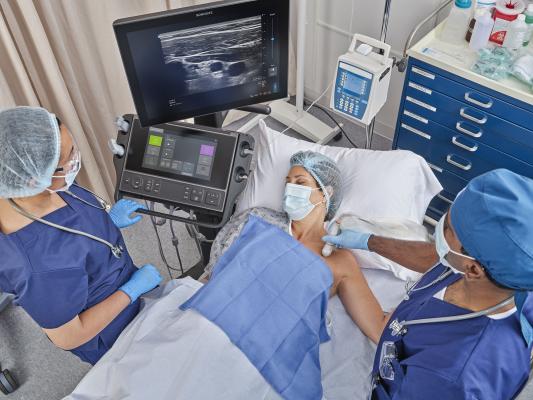
February 15, 2022 — Fujifilm Sonosite, Inc. – a world leader in point-of-care ultrasound (POCUS) solutions – has added to its next-generation POCUS portfolio with the launch of its new, premium Sonosite LX system, featuring the company’s largest clinical image and a monitor that extends, rotates and tilts to enable enhanced, real-time provider collaboration. The clinical display features touchscreen controls to enable an optimized heads-up workflow, allowing clinicians to keep their eyes on the image while making adjustments.
Designed to be used with the Sonosite LX and Sonosite PX, the company has also launched a new T8-3 transesophageal transducer and Cardiac Resuscitation exam type, to assist clinicians in using transesophageal ultrasound (TEU) at the point of care.
“Sonosite LX was inspired by and designed with clinician partners, focusing on the evolving ways ultrasound can support the quadruple aim at the point of care, wherever that may be,” said Rich Fabian, president and COO, Fujifilm Sonosite. “This launch reflects an ongoing commitment to delivering leading edge technology for clinicians and their patients, technology that’s backed up by a world-class ecosystem of services, support and education.”
Sonosite LX Point of Care Ultrasound System
Sonosite LX has a large, adaptable 21.3” clinical display that extends, rotates and tilts to accommodate the varied clinical environments at the bedside. The system’s small footprint and adjustable display foster collaboration, allowing for real-time image and information sharing with the patient, other clinicians, residents and other hospital staff.
The system was engineered to include primary and secondary study controls on the clinical touchscreen display – including quick access to the most-used optimizations such as depth, gain, and measurements - to deliver an optimized heads-up workflow for clinicians. The Sonosite LX is compatible with the redesigned family of transducers launched with Sonosite PX that have dedicated exam types for study-specific imaging and workflow optimization.
Cardiac Resuscitation Exam Type
Sudden cardiac arrest is the leading cause of natural death in the U.S. according to American College of Emergency Physician guidelines transesophageal echocardiogram allows the emergency physician to maintain the standard of an ultrasound-informed resuscitation in the scenario of cardiac arrest, where transthoracic echocardiogram is significantly limited. With TEU patients can benefit from more accurate and efficient chest compressions while being evaluated with ultrasound, potentially making the response to a cardiac emergency more effective. Clinicians must act swiftly to ensure imaging does not interrupt or delay compressions, so having the right equipment and cardiac views can be critical.1,2
Fujifilm Sonosite developed its new cardiac resuscitation exam type to address this need, leveraging insights from physician-leaders in POCUS and the strength of Sonosite as the company that launched the point of care ultrasound category.
Fujifilm Sonosite T8-3 Transesophageal Ultrasound (TEU)
Responding to expressed customer need, Sonosite developed the T8-3 transducer, enabling clinicians to provide TEU at the point of care by:
- Enabling repeatable cardiac imaging regardless of patient condition or body habitus.
- Providing a lightweight handle and flexible shaft for easy manipulation and a small tip for ease of insertion.
- Enabling low power consumption to maintain temperature while monitoring over time.
- Delivering FUJIFILM Sonosite’s most advanced image clarity.
Abbott Northwestern in Minneapolis recently purchased six T8-3 transducers to aid in cardiac resuscitation throughout their hospital.
“We want to provide our physicians with the tool that ensures real-time heart and lung visualization during patient resuscitation when transcutaneous imaging windows are inadequate and a patient, regardless of location in the hospital, might benefit,” said Dr. David Tierney, Program Director, Abbott Northwestern Hospital Internal Medicine Residency Program, part of Allina Health. “This information helps our resuscitation team make rapid and potentially life-saving decisions at the bedside and further improve shock and arrest outcomes for our patients.”
The Sonosite LX, T8-3 Transducer, and Cardiac Resuscitation exam type are now commercially available in the United States, Australia and New Zealand, with plans to launch in Canada, Europe, China and Japan in the future. To learn more about the Fujifilm’s portfolio of POCUS solutions, visit this webpage.
As with all Sonosite point of care ultrasound systems, Sonosite LX is built to legendary durability, reliability, and ease of use standards. The ultrasound transducers are drop-tested to one meter and the work surface is sealed to the edge for simplified cleaning and disinfection.
1 Prognostic value of point-of-care ultrasound during cardiac arrest: a systematic review
2 Point-Of-Care Ultrasound (POCUS) for Cardiac Resuscitation
For more information: www.sonosite.com
Related POCUS Content:
VIDEO: Imaging COVID-19 With Point-of-Care Ultrasound (POCUS)
Utility of Point-of-Care Ultrasound Across Clinical Applications Spurs Continued Growth


 December 04, 2025
December 04, 2025 









